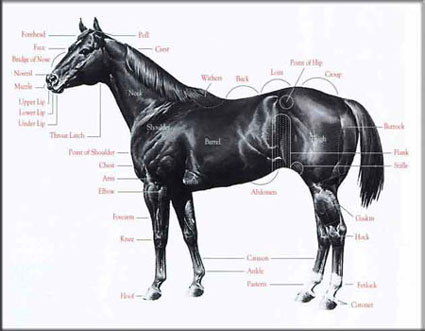Each of the light horse breeds requires slightly different characteristics about the head. These should be considered when breed classes are judged. In general,
the head should be well proportioned to the rest of the body, refined and clean-cut, with a chiseled appearance. A broad forehead, with great width between the
eyes is desired. The face should be straight as compared to convex (Roman nose) or concave (excessive dished).
The head should join the neck at about a 45 degree angle with a distinct space between the jawbone and the neck. The throat latch should be clean-cut. Depending
on the breed, the neck should be medium in length to fairly arched, lean and muscular, and blend smoothly into the shoulder. A high-arched or heavy-crested neck
is undesirable.
The shoulder is long and set at an angle of about 45 degrees from the withers down to the point of the shoulder. Shoulders should be smooth yet well-muscled. The
withers should be well-defined, extend well-back beyond the top of the shoulder. Low, flat withers do not hold a saddle well.
The top-line should include a short, strong back and loin, a long, nicely-turned and heavily muscled croup, and a high well-set tail. The loin (coupling) must be
short and very strongly muscled because it supports the weight of the saddle and rider, and lifts the forequarters when the horse is in motion.
The chest is deep and fairly thick, with this depth and thickness extending back into the barrel. A deep heart girth and well-sprung foreribs give room for good
respiratory and digestive capacity. The forelegs are wide-set and blend smoothly into the shoulder. The forearm muscle is large and tapers into the knee when
viewed from the back or front. The knee joint should be clean and the pastern medium in length. The pastern and the hoofs are set at about a 45 degree angle to
the ground.
The bones of the legs should be flat, clean, and free from fleshiness and puffiness. The bone should be of adequate strength and substance to support the horse
during strenuous performance.
The hock should be large, clean-cut, wide from front to back, and deep. Gaskin muscles should tie-in very strongly and low on the hock. The knee should be wide
when viewed from the front, deep, and clean-cut. When viewed from the front or rear the knees and hocks ahould be bisected by an imaginary vertical line down
the center of the legs. Tendons below the knees and hocks appear sharply separated from the cannons, giving the leg a flat appearance.
The rear quarters should be thick, deep, and muscled when viewed from the side or rear. This muscling shows in thickness through the thigh, stifle, and gaskin.
The hind legs are muscled both inside and out, with the gaskin tied in low into the hock joint. The hocks are wide, deep, and clean.
 Home Page
Home Page
 Top of Page
Top of Page

